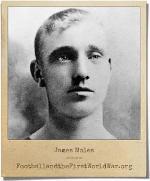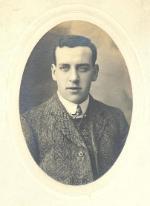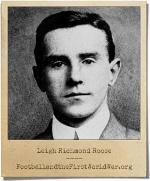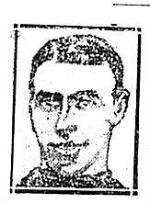For Some The Match Finished Too Early!
18/07/2019 - 1.00
Douglas Smith

I once lost a girlfriend because I chose to stay at college and play in goal rather than go home and spend the weekend with her. I was the goalkeeper and tried to explain that I couldn’t be replaced and that I would be letting the team down but she didn’t listen and dumped me. The point is when I’m asked, ‘…why did so many sportsmen join up in the First World War?’ - the answer is very much the same: they didn’t want to let their team mates down!
Looking through those who died in the war in local newspapers of the time it struck me how many of them played football. Sometimes this was for professional teams like Aston Villa, West Bromwich Albion or Birmingham City but the more frequent were those who died from amateur teams such as Moor Green, Moseley Road Wesleyans or the Kings Heath Melrose Football Club.
 In June, I delivered a talk to Year 8 pupils in Chelmsley Wood about some of the players who died from the three professional teams and also Moor Green Football Club. One of the first to die was James Moles, an aggressive right-half for Birmingham City who made 22 appearances for the club until injury caused him to lose his place and return to London where he was born. He died of his wounds, aged 31, on the 7th November 1915.
In June, I delivered a talk to Year 8 pupils in Chelmsley Wood about some of the players who died from the three professional teams and also Moor Green Football Club. One of the first to die was James Moles, an aggressive right-half for Birmingham City who made 22 appearances for the club until injury caused him to lose his place and return to London where he was born. He died of his wounds, aged 31, on the 7th November 1915.
 One of the most talented players to die was 2nd Lieutenant Harold Bache. He was a very talented sportsman playing cricket for Worcestershire and football for the mighty Corinthians. He was capped for the England Amateur team playing against Wales, Bohemia, France and Spain. He had the distinction of scoring seven goals in one match for them against Ipswich Town on New Year’s Eve 1910. He joined West Bromwich Albion in 1913 but joined the Lancaster Fusiliers as soon as war was declared. He was killed by a sniper’s bullet, aged 26, on 16th February 1916. He has no known grave and is remembered on the Menin Gate, Ypres.
One of the most talented players to die was 2nd Lieutenant Harold Bache. He was a very talented sportsman playing cricket for Worcestershire and football for the mighty Corinthians. He was capped for the England Amateur team playing against Wales, Bohemia, France and Spain. He had the distinction of scoring seven goals in one match for them against Ipswich Town on New Year’s Eve 1910. He joined West Bromwich Albion in 1913 but joined the Lancaster Fusiliers as soon as war was declared. He was killed by a sniper’s bullet, aged 26, on 16th February 1916. He has no known grave and is remembered on the Menin Gate, Ypres.
 The deaths from Moor Green Football Club were far greater than those of the three professional clubs with 15 players recorded as having lost their lives. Moor Green had been established before the war by Ashfield Cricket Club and many of the cricketers went on to play football in the winter with them. One of those to die was 2nd Lieutenant Bill Sanby. He was educated at King Edward’s School, New Street, Birmingham and followed friends to play cricket with Ashfield and football for Moor Green. He joined the 14th Battalion Warwickshire Regiment at the outbreak of war. This was the first of Birmingham’s three ‘Pals’ Battalions. Bill was promoted to 2nd Lieutenant in the 20th Battalion Northumberland Fusiliers. On the first day of the Somme, 1st July 1916, his Battalion was stationed to the left of the Lochnagar Crater, which was created by a huge underground explosion as mines were detonated under German lines. At the allotted time Bill blew his whistle and led his men forward with he and many of his companions were almost immediately cut down by German machine gunfire. His body was never recovered and he is remembered on the Thiepval Memorial.
The deaths from Moor Green Football Club were far greater than those of the three professional clubs with 15 players recorded as having lost their lives. Moor Green had been established before the war by Ashfield Cricket Club and many of the cricketers went on to play football in the winter with them. One of those to die was 2nd Lieutenant Bill Sanby. He was educated at King Edward’s School, New Street, Birmingham and followed friends to play cricket with Ashfield and football for Moor Green. He joined the 14th Battalion Warwickshire Regiment at the outbreak of war. This was the first of Birmingham’s three ‘Pals’ Battalions. Bill was promoted to 2nd Lieutenant in the 20th Battalion Northumberland Fusiliers. On the first day of the Somme, 1st July 1916, his Battalion was stationed to the left of the Lochnagar Crater, which was created by a huge underground explosion as mines were detonated under German lines. At the allotted time Bill blew his whistle and led his men forward with he and many of his companions were almost immediately cut down by German machine gunfire. His body was never recovered and he is remembered on the Thiepval Memorial.
 One of Aston Villa’s five men to die was Private William Gerrish 17th Battalion (The Footballers Battalion) Duke of Cambridge’s Own (Middlesex Regiment). He was a nippy inside-forward and made 58 appearances for them from 1909 to 1912, scoring 18 goals. He joined the 17th Battalion in February 1915. This Battalion had been formed by MP William Joynson-Hicks in Fulham in December 1914 as a reaction to the fact that football teams had continued to play matches after war was declared. It was known as the ‘Football Battalion’ and included many famous footballers in its ranks including its first recruit, English International Frank Buckley. William died on the Somme in the attack at Delville Wood on 8th August 1916. A shell blasted destroyed both his legs. Legend says that he lay quietly smoking a cigarette until he was picked up by the stretcher bearers but died, aged 31, later that day. He is remembered on the Thiepval Memorial.
One of Aston Villa’s five men to die was Private William Gerrish 17th Battalion (The Footballers Battalion) Duke of Cambridge’s Own (Middlesex Regiment). He was a nippy inside-forward and made 58 appearances for them from 1909 to 1912, scoring 18 goals. He joined the 17th Battalion in February 1915. This Battalion had been formed by MP William Joynson-Hicks in Fulham in December 1914 as a reaction to the fact that football teams had continued to play matches after war was declared. It was known as the ‘Football Battalion’ and included many famous footballers in its ranks including its first recruit, English International Frank Buckley. William died on the Somme in the attack at Delville Wood on 8th August 1916. A shell blasted destroyed both his legs. Legend says that he lay quietly smoking a cigarette until he was picked up by the stretcher bearers but died, aged 31, later that day. He is remembered on the Thiepval Memorial.
 Another Villa player to die was the outstanding goalkeeper, Leigh Roose. Whilst playing for Stoke he kept 40 clean sheets for a very weak team. He was a formidable 13 stone and 6 feet 1 inch tall. He started the war in the Royal Army Medical Corps where he gained the Military Medal for his bravery but re-enlisted in the Royal Fusiliers in 1916. He died in a later attack on the Somme, aged 38, on 7th November 1916.
Another Villa player to die was the outstanding goalkeeper, Leigh Roose. Whilst playing for Stoke he kept 40 clean sheets for a very weak team. He was a formidable 13 stone and 6 feet 1 inch tall. He started the war in the Royal Army Medical Corps where he gained the Military Medal for his bravery but re-enlisted in the Royal Fusiliers in 1916. He died in a later attack on the Somme, aged 38, on 7th November 1916.
Another Moor Green player was Captain Charles Lesley Young, Royal Naval Air Service. He is recorded as L. Young on the Moor Green Memorial. He won the Distinguished Flying Cross for bravery whilst hunting submarines in the Channel. He was killed flying across the Channel. His plane came down into the water and while there they were staffed by a German plane, which was against the rules of war, causing his death and two of the members of his crew. The other two were taken prisoner. He died, aged 28, on 30th May 1918 and is remembered on the Hollybrook Memorial, Southampton.
 To finish, I’ll end with one of my favourite stories and that is of the Birmingham inside forward Benny Green. He played for a number of professional teams: Barnsley 1901, Birmingham 1903, Burnley 1909, Preston North End 1911, Blackpool 1913. He made 198 appearances for the Blues scoring 6 goals. He was described as a ‘chunky bag of tricks’ and had the honour of scoring the first goal to be scored at St. Andrews which earned him the prize of a piano! He joined the King’s Own Royal Lancashire Regiment meeting his end in the ill-planned attack at Arras on 26th April 1917 and is remembered on the Arras Memorial.
To finish, I’ll end with one of my favourite stories and that is of the Birmingham inside forward Benny Green. He played for a number of professional teams: Barnsley 1901, Birmingham 1903, Burnley 1909, Preston North End 1911, Blackpool 1913. He made 198 appearances for the Blues scoring 6 goals. He was described as a ‘chunky bag of tricks’ and had the honour of scoring the first goal to be scored at St. Andrews which earned him the prize of a piano! He joined the King’s Own Royal Lancashire Regiment meeting his end in the ill-planned attack at Arras on 26th April 1917 and is remembered on the Arras Memorial.
WE WILL REMEMBER THEM.
Biography
Douglas was educated at Sheldon Heath Comprehensive School having failed his 11 plus which was a stroke of good fortune because he assumed it was because he wasn’t bright and therefore had to work much harder. Sheldon was an excellent school with committed teachers. It gave Douglas opportunities to achieve and he went to Worcester College of Education and came out with a Bachelor of Education Degree. He then taught in Birmingham schools for the next 38 years, gaining a Masters of Education Degree in 1984 before finally retiring in 2011. Douglas was awarded an M.B.E. for services to Education in 2012. Since retiring he has become a speaker and author. Douglas has had three books published all based on the First World War. They are:
‘From Trams to Trenches’ which tells the story of the members of the Birmingham Tramways Department who died in the war.
‘Cheer Boys it’s Hartlebury’ which is based on original autograph books left by the soldiers who attended Hartlebury VAD Hospital in the First World War.
‘Who’s for the Game?’ which is the unique story of the men from four Birmingham sports clubs, Moseley Rugby, Moor Green Football, Ashfield Cricket Club, and Moseley Golf Club who died in the war.
You can find Douglas on Twitter at @Historydoug and his website is - www.Historynut.co.uk


/prod01/wlvacuk/media/departments/digital-content-and-communications/images-2024/240624-Alumni-Awards-2024-Resized.jpg)
/prod01/wlvacuk/media/departments/digital-content-and-communications/images-18-19/220325-Engineers_teach_thumbail.jpg)
/prod01/wlvacuk/media/departments/digital-content-and-communications/images-2024/240627-UN-Speaker-Resized.jpg)
/prod01/wlvacuk/media/departments/digital-content-and-communications/images-2024/240320-Uzbekistan-Resized.jpg)
/prod01/wlvacuk/media/departments/digital-content-and-communications/images-2024/240229-The-Link-Resized.jpg)
/prod01/wlvacuk/media/departments/digital-content-and-communications/images-2024/240627-Lady-Aruna-Building-Naming-Resized.jpg)